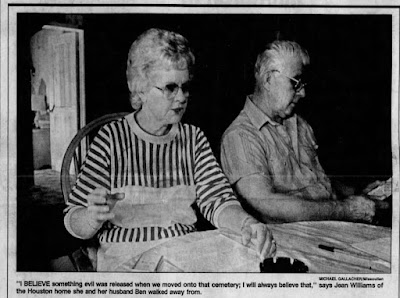When you move into a new home, it’s expected that there will be one or two unpleasant surprises. Maybe the plumbing isn’t all that it should be, or the neighbors throw a lot of noisy parties, or, oops, your couch won’t fit through the front door. What you don’t expect to deal with are a bunch of corpses in the backyard that hold a grudge against you. But, as you will see, such things sometimes happen.
In the early 1980s, developers completed a housing subdivision in Newport, just outside of Houston, Texas. It was designed for upper-middle class families wanting a quiet, scenic refuge that still provided an easy commute to the big city. Among the first people to move in were Ben and Jean Williams. From the moment the couple settled into their home, they felt an inexplicable sense of unease, as if they were being watched by an unfriendly presence. There also were more tangible difficulties: toilets that flushed themselves, flickering electric lights, a garage door that opened and closed on its own, and a yard that was always full of poisonous snakes. The couple began sensing shadowy figures just beyond their peripheral vision. Adding to the atmosphere of quiet menace was the fact that a tree in their backyard was dotted with peculiar markings--downward pointing arrows with slash marks underneath them--and the ground was covered in rectangular sinkholes. The Williams’ neighbors told them that they were experiencing the same uncanny problems.
The source for the subdivision’s strange woes remained a mystery until 1983, when two other Newport residents, Sam and Judith Haney, began building a swimming pool in their backyard. The excavation uncovered two very old coffins containing the remains of a man and a woman.
This disturbing discovery caused the Newport families to do a bit of detective work about their properties. This led them to an elderly retired gravedigger named Jasper Norton. He informed them that their neighborhood was built on top of an old cemetery called Black Hope. Underneath their beautiful, well-maintained homes were at least sixty bodies, most of them former slaves. Norton informed the Haneys that they had accidentally disinterred the remains of Betty and Charlie Thomas, who had died in the 1930s.
The Haneys--not knowing what else to do--decided to rebury the couple in their yard. Unfortunately, this does not appear to have placated Mr. and Mrs. Thomas. The Haney house was immediately plagued by some very annoyed ghosts. The Haneys would hear spectral voices and footsteps throughout the hallways. A clock--unplugged at the time--began to glow and shoot sparks. One night, Judith was alone in the house when she heard the sliding glass doors open and close. She assumed it was Sam returning from work, but when she went downstairs, nobody was there. The next morning, she found a pair of her shoes resting on top of Betty Thomas’ grave. Before long, the entire subdivision was facing similar supernatural menaces. Unsurprisingly, the neighborhood became nearly deserted, with many people preferring foreclosure over phantoms.
The Williamses and the Haneys were among the few families who opted to stick it out. They would soon regret this. Both families began suffering inexplicable health problems. Those ominous rectangular sinkholes kept reappearing in their yards, no matter how many times they would add dirt to them. The disembodied footsteps continued to march through their rooms. One night, Ben Williams saw a spectral figure floating over his sleeping wife. When the Williams' eight-year-old granddaughter Carli visited them, she would talk to "the dead people" in her sleep. "They don't want us here," the girl told her elders.
The Haneys sued the neighborhood’s developer for not disclosing the seemingly relevant fact that the subdivision was built over a cemetery. The jury awarded them a settlement, but this was reversed by a judge. The development company then counter-sued the Haneys for harassment. The exhausted couple felt they had no choice but to declare bankruptcy and abandon their new home. The Williamses, on the other hand, were determined to stick it out. They too wanted to sue their developer, and were anxious to find additional evidence against the company. When in 1987, an old-time resident of the area told them that the odd arrow marks on their tree indicated the site where two sisters had been buried, Jean got a shovel and began to dig. Later that day, Jean’s daughter Tina, who had come by for a visit, suffered a heart attack which led to her death three days later. She was only thirty years old.
 |
| "The Missoulian," June 9, 1991, via Newspapers.com |
After this tragedy, the Williams family just wanted to get as far away from the--literally--damned house as they could. They were convinced that moving on top of the cemetery had released “something evil.” The couple abandoned the property and moved to Montana. Curiously, Tina’s death appeared to mark the end of the subdivision’s haunting, leaving the remaining residents to live in peace. Perhaps the unquiet ghosts of the old cemetery felt they had finally gotten their revenge.
So similar to the plot of Poltergeist, which I believe was based on a true story.
ReplyDeleteVery frightening, especially if you'd put a lot of money and effort into the new home and couldn't just pull out and move. It sounds very reminiscent of the plot of "Poltergeist", yet that movie was released in 1982, and photography was completed for it in 1981, so the Texas story can't be its source. Just a very remarkable coincidence?
ReplyDelete